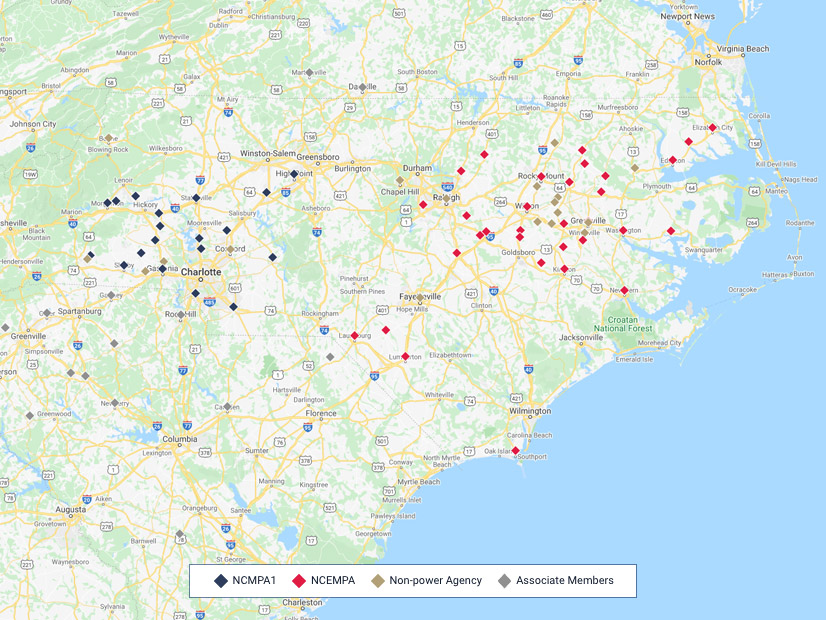
The D.C. Circuit Court of Appeals said Friday it would not “second guess” FERC’s interpretation of a power purchase agreement between Duke Energy Progress (NYSE:DUK) and the North Carolina Eastern Municipal Power Agency (NCEMPA), upholding a ruling that allowed the latter to use storage to reduce its capacity charges (20-1495).
NCEMPA, which serves 32 cities and towns with municipal electric distribution systems, asked FERC in 2019 to issue an order declaring that its 2015 “full requirements” PPA with Duke permitted it to use battery storage to reduce the munis’ load during the peak hour each month that is used to determine capacity charges.
The capacity charge — based on NCEMPA’s pro rata share of the demand on Duke’s system during the one-hour peak — is intended to cover Duke’s fixed costs and provide a return on its infrastructure investments. NCEMPA also pays an energy charge to reimburse Duke for its fuel costs and variable operations and maintenance costs.
The munis cited sections 9.4 of the PPA, which permits demand-side management (DSM) (e.g., end users allowing the agency to turn off appliances during high-demand periods), and section 9.5, which permits demand response (end users acting themselves to curtail consumption in response to real-time price signals).
Duke spokesperson Randy Wheeless said the company was disappointed by the D.C. Circuit’s ruling. The company asked FERC in December to approve revisions to the PPA on the assumption that the commission’s ruling would be upheld on appeal (ER22-682).
“Although Duke Energy is supportive of battery storage technology, we must be mindful how the current rate design could potentially shift costs and unfairly burden other customer groups,” Wheeless said Saturday. “As more energy storage devices are deployed, this issue will continue to arise between utilities and wholesale customers.”
FERC Order
FERC granted NCEMPA’s request in an order in September 2020 (EL20-15). (See NC Muni Wins Right to Add Storage over Duke Objections.)
In its appeal, Duke contended that batteries don’t qualify as DSM or DR. And it said allowing NCEMPA to use batteries would make the PPA “confiscatory” by permitting the agency to reduce its demand to zero during the system peak, eliminating its payments toward Duke’s fixed costs.
The D.C. Circuit said the case hinged on two competing interpretations of section 9.5, which it called “a model of ambiguity.
“It does not define demand response; it never mentions batteries; and interpreting the provision required the commission to infer the meaning of two of its terms, ‘demands’ and ‘load,’ by reference to another provision of the agreement,” Circuit Judges Karen LeCraft Henderson, David S. Tatel and Cornelia Pillard ruled in an opinion written by Tatel.
Duke contended that section 9.5 only permitted reducing demand through communication of pricing information to the agency members and their customers. FERC concluded that the language allowed NCEMPA to reduce members’ demand through the use of pricing information — specifically the “combined system load signal” — data that allow the agency to predict when the maximum demand on Duke’s system will occur.
FERC noted that “Duke will continue to supply (and [NCEMPA] will continue to pay for) the energy needed to charge any batteries.”
“Given that we must ‘defer to the commission’s construction of the provision at issue so long as that construction is reasonable,’ it is not enough for Duke to offer its own reasonable interpretation of the provision,” the court said. “Instead, Duke must demonstrate that the commission’s interpretation is unreasonable. It has failed to do so.”
The court said section 16 of the PPA outlines a process for Duke to propose changes to the agreement if the utility has “concerns regarding whether the contract remains appropriately compensatory.”
“Accordingly, should [NCEMPA] deploy its batteries in a way that renders the agreement ‘confiscatory,’ Duke can return to the commission for relief,” the court said.
Contract Revision Sought
Duke did just that in seeking to reopen the PPA on Dec. 17.
“The enclosed rate design change is required because, even since the commission’s interpretation of the contract, certain power agency members have publicly and clearly announced their intention to procure enough battery storage technology to drastically reduce, and even eliminate entirely, their responsibility for capacity charges by superficially reducing or eliminating their demand only during the single coincident peak hour of the month, even though their reliance on the [Duke] system during the majority of other hours in the month continues unabated,” it said.
NCEMPA protested, saying Duke’s
“proposal would penalize the development of distributed energy resources, not only by NCEMPA and its members, but also by the members’ retail customers, thus increasing the cost of the resource transition, undermining reliability, and potentially increasing the use of carbon-emitting resources.” On Monday, NCEMPA filed a motion to lodge the D.C. Circuit’s ruling in the FERC docket.
Drew Elliot, manager of government affairs for NCEMPA parent ElectriCities of NC, said two of the agency’s larger member utilities — each 1,000 kW AC — have installed pilot battery projects since May 2019. “They are operated by the individual utilities, not the power agency, and are used for peak shaving,” Elliot said.


